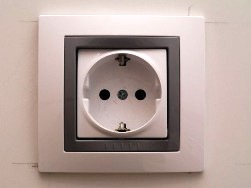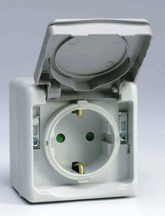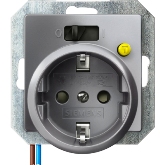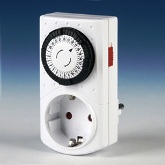Categories: Interesting electrical news, Electrician at home, Electrical Reviews, Sockets and switches
Number of views: 86786
Comments on the article: 7
Technical tricks of household outlets
 Most manufacturers of sockets, switches spend considerable money on ensuring maximum security for ordinary consumers and raising the level of comfort during the operation of electrical appliances.
Most manufacturers of sockets, switches spend considerable money on ensuring maximum security for ordinary consumers and raising the level of comfort during the operation of electrical appliances.
For example, many manufacturers equip their protective shutter sockets. It will not work to insert any foreign object other than the plug from electrical appliances into the outlet of the outlet.
Such sockets Ideal for installation in apartments where small children grow. Because the curiosity of the kids is no secret, many of the kids constantly strive to stick something into the socket outlet. In addition, recently, almost everyone who makes repairs install sockets at a level of 35-40 cm from the floor.
The presence of curtains also serves as additional protection against the ingress of foreign objects, dust, moisture into the outlet mechanism. The degree of protection is written on all electrical appliances in terms of electrical safety.
To determine the degree of protection of electrical appliances, there is a universal international IP system. For example, IP24, IP44, etc.
The first digit shows the dimensions. The second digit shows the protection against solid particles, moisture.
Now you can roughly determine the degree of security that you need. For example, for sockets and other electrical appliances for the bathroom, the degree of protection IP44 is sufficient.
 For rooms with an increased likelihood of electric shock, in case of breakdown of insulation, and such rooms include a bathroom, kitchen, garage, it is necessary to install in distribution boards RCD (residual current device).
For rooms with an increased likelihood of electric shock, in case of breakdown of insulation, and such rooms include a bathroom, kitchen, garage, it is necessary to install in distribution boards RCD (residual current device).
An RCD, in the event of a leakage of a current of a certain magnitude, will disconnect the group of outlets where the leakage occurred, thereby protecting a person from electric shock. The device and principle of operation of the RCD, we considered in the previous article.
But all this is good in theory. How is things really going? After all, it is not always possible to install a separate RCD on the group to which the socket we need is connected. You can, of course, put one common RCD for the whole house, but then, in the event of a device being triggered, the whole house will remain without electricity.
It is for such situations when it is necessary to protect themselves and others from electric shock, manufacturers came up with sockets in which an RCD is already mounted. Such socket with RCD can be installed instead of the usual kitchen outlets or in the bathroom.
 If you live in a private house, then you probably sometimes use various electrical appliances on the street - a lawn mower, a drill, a vacuum cleaner, etc. .. In this case, there is a need to install somewhere, in a convenient place, an external outlet equipped with UZO protection.
If you live in a private house, then you probably sometimes use various electrical appliances on the street - a lawn mower, a drill, a vacuum cleaner, etc. .. In this case, there is a need to install somewhere, in a convenient place, an external outlet equipped with UZO protection.
Recently, a new device has appeared in stores and markets selling electrical accessories - timer socket. To use the device, there is no need to interfere with an existing wiring.
 It is enough just to plug the timer-socket into an ordinary socket, then you "stick" the device we need into the device itself and everything is ready to work. A timer socket can be used, for example, to turn on a heating appliance, lamps, etc. at a certain time.
It is enough just to plug the timer-socket into an ordinary socket, then you "stick" the device we need into the device itself and everything is ready to work. A timer socket can be used, for example, to turn on a heating appliance, lamps, etc. at a certain time.
There is another innovation that has appeared in our electrical stores - sockets with remote control.
There is a remote control reminiscent of an ordinary television. So, with this remote control you can control the on / off of devices that are previously included in the sockets-adapters.
Our kitchens, in which our lovely and beloved ladies spend a lot of time, can be equipped sockets with a device for pushing out sockets.
It looks like an ordinary outlet, on the case of which there is a small button. When we need to pull the plug from the outlet, just click on it, and ... the plug itself leaves the outlet.
There are also retractable socketsthat hide in a table, cupboard or any other surface, and if necessary can be moved out and used for their intended purpose.
In any case, before purchasing any device, consult a professional for reliability and the possibility of replacement, in the event of failure, for example, of an outlet, switch, lamp.
Sergey Seromashenko
We recommend reading:How to choose the right sockets for an apartment or a house
See also at bgv.electricianexp.com
:
